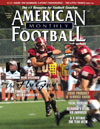AMERICAN FOOTBALL MONTHLY THE #1 RESOURCE FOR FOOTBALL COACHES
Article CategoriesAFM Magazine
|
The Shotgun Wing-T Bucksweep SeriesSpreading Out the Defense© More from this issue Since moving to the Shotgun Wing-T, the Capital Bruins have led the state of Montana in rushing yards and have been to the State Championship twice, winning the title in 2006. We still run traditional Wing-T sets but have found the Spread Shotgun sets useful in spreading defenses out. Like many Wing-T teams, we occasionally get a defense that will load the box with eight or nine to stop our running game. The Shotgun Wing-T gives us an answer for this situation and allows us to take advantage of single coverage and get the ball to our receivers. This article will focus primarily on the bucksweep out of the Spread Shotgun set. Advantages The Shotgun allows the QB to read the play as it is happening. He has a good view of the defensive end and he can then read this defender similar to an option play. We therefore do n....The full article can only be seen by subscribers. Subscribe today!
|
|
|||||||
| HOME |
MAGAZINE |
SUBSCRIBE | ONLINE COLUMNISTS | COACHING VIDEOS |
Copyright 2025, AmericanFootballMonthly.com
All Rights Reserved





